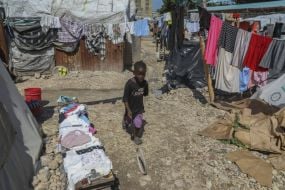The UK has experienced three times more cases of scarlet fever than usual, a senior health official has said.
The latest figures show that at least 19 children have now died across the UK from invasive Strep A disease.
Irish epidemiologist Professor Susan Hopkins, who is the chief medical adviser at the UK Health Security Agency (UKHSA), said the vast majority of children affected have a mild illness and that an “open mind” is being kept as to why there is a spike in infections.
Speaking on BBC Radio 4’s Today programme, she said: “The latest with scarlet fever and Strep A infections are that we’ve seen about just over 7,500 notifications of scarlet fever, and that’s probably an underestimate.
“We have a lot of reports coming in in the last few days so we expect it to be even higher.
“That’s about three times higher than the same time in a normal season. The last bad season we had in 2017 and 18.
Most strep A infections are mild and easily treated, but some are more serious.
Visit the NHS website to learn more about symptoms to look out for, when to seek medical help and what to do in an emergency. ➡️ https://t.co/2TUbmO8nFb#StrepA #GroupAStrep pic.twitter.com/To5B9YzseA— UK Health Security Agency (@UKHSA) December 12, 2022
“And in invasive Group A Strep cases, we are more than halfway through what we’d normally see in an average season.
“We’ve seen 111 cases in children aged one to four and 74 cases in children aged five to nine.”
Invasive group A strep (iGAS) is the most severe and unusual form of infection.
She said those numbers at the severe end are small, adding: “The vast majority of children have a self-limiting or mild illness and are being managed very well.”
Prog Hopkins was asked if it is yet known why there has been a spike in infections of scarlet fever and Strep A and whether it is due to children’s immunity levels being weakened after socialising less during the pandemic.
“We would not say we’re convinced of anything yet. I think we’re seeing this season much, much earlier,” she said.
“We’ve got a lot of children who have not had this infection over the last three years, so there’s more susceptible children who have not started to develop their immunity to this infection, which we get repeated times over the course of our lives.
Strep A: Analysis by UKHSA suggests a nasal spray vaccine that offers protection to children against flu may also help reduce the rate of group A strep infections.
Read more ➡ https://t.co/f6zrgKNdgm#StrepA pic.twitter.com/62WSuINiFo— UK Health Security Agency (@UKHSA) December 16, 2022
“Of course, we’re always looking for other reasons. Has the bacteria changed? Is there any other changes in that might have occurred that are causing this? So while we think at the moment, the most likely explanations from everything we’ve looked at, is the fact that this relates to lack of exposure for a period of time, we will keep an open mind and look elsewhere.”
It is understood that health officials in Britain do not believe the number of scarlet fever infections has yet peaked, suggesting more deaths are likely.
Meanwhile, concern about strep A in Ireland and a “significant increase” in viral infections in the community has prompted the HSE to write to all schools urging them to encourage parents to ensure children with signs of illness to be kept at home.
It comes after the death of a four-year-old in the north Dublin/northeast health region, and the death of a five-year-old girl from a severe form of strep A in the Belfast area.
Strep A infections such as scarlet fever and impetigo are treated with antibiotics, with penicillin among the most commonly used.

Scarlet fever symptoms are often flu-like, including a high temperature, a sore throat and swollen neck glands.
A rash appears 12 to 48 hours later, starting on the chest and stomach and then spreading.
A white coating also appears on the tongue which peels, leaving the tongue red, swollen and covered in little bumps (often called “strawberry tongue”).







